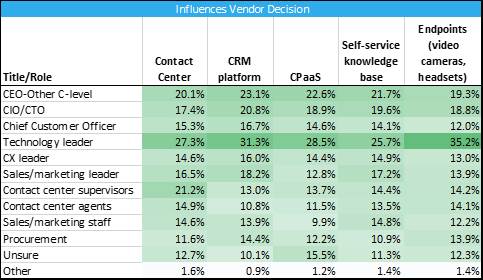As the number of customer experience (CX) technology options increases, the buying process has become more complex—particularly in large companies. A growing number of people within the company have a vested interest in CX platforms, applications, and customizations.
As a result, the buying cycle for CX technologies is longer, the expectations for vendors are more intense, and the need for top-notch leadership is more important than ever.
Though the descriptions vary from organization to organization, most organizations have the following roles:
- Decision-makers – These are most frequently technology experts who understand vendors, service providers, products, and services. They make decisions largely based on requirements from the business unit leaders that also align with the company’s security, legal, and procurement policies.
- Funders – These are a mix of people. When the purchase is a foundational technology (platforms, network services, security, etc.), the technology leader, such as a CIO, CTO, VP of IT, IT director, etc., commonly funds. When the purchase is an application or suite of apps, business leaders fund.
- Influencers – These also are a mix of people broader than those involved with decisions and funding. They may include business leaders, executives, contact center agents, customers, sales teams, marketing leaders, or procurement. By definition, they don’t decide on the technology or the provider—but they can have incredible influence over both—so much that many say it’s impossible to win the business without them.
In 50% of CX technology buying decisions, the funder and decision-maker are the same person—but in 50% of the cases, they’re not, according to Metrigy’s Customer Experience Transformation 2022-23 research study of 724 organizations globally. The latter situation involves more complex and time-consuming sales processes simply because of the number of people, the number of questions, and the time it takes for the multiple decision-makers to settle on the right solution.
Decision-makers vary somewhat depending on the type of CX technology in question. For example, with contact center platforms, technology people make decisions in 59.5% of companies, while the Chief Customer Officer or CX leader does the same in 35% of companies. The results are similar for CRM and CPaaS, though sales and marketing leaders show up more prominently for CRM; in those areas, 33.2% of the decisions (not necessarily funding) come from a CEO or other C-level executive (not including the CIO, CTO, or Chief Customer Officer).
Funders are more often C-level executives and the CCO, specifically, for the contact center. Technology leaders fund the contact center in fewer than half the contact center buying decisions.
When it comes to influencers, they are spread across many titles, as shown in the table below. That’s why vendor sales teams need to identify the roles of everyone involved in the sales process for CX technology decisions. Typically, the salespeople have “coaches” within the enterprise organization who should be able to point these people out. Or, while in group meetings, it’s perfectly acceptable to ask people what their role is in the project. For contact centers, supervisors and agents often influence the decisions, while sales and marketing teams influence customer relationship management (CRM) decisions. Overall, across all CX technologies measured, technology leaders continue to be at the forefront—if they’re not making or funding the decisions, they’re certainly influencing them.
Of course, influencers can positively or negatively influence vendors or the whole project. Some are highly regarded company-wide because of their knowledge, so their voice carries a lot of weight when it comes time to make a decision.
Others can trigger problems or changes—some of which aren’t their fault. For example, in one large project I was involved with, the vendors and the project team were aggravated with the security leader because he kept throwing cold water on every idea. However, the project team brought him in for a rubber stamp at the very end of the project—not allowing him the time he needed to resolve security issues. That brought down the entire project, but it was avoidable if he had involved himself from the start. In other cases, I’ve seen business leaders with little technology experience ask insightful questions about the business impact that shifted the project to drive more success.
Too Many Cooks in the Kitchen
With all these people playing some role in selecting CX technologies--is the company decision-making process becoming too inclusive? I’ve been part of many enterprise technology decisions where simply too many people were involved (or sometimes, not the right people involved).
That’s not to say input from a broad range of internal experts and partners is a bad thing. Indeed, good leaders should involve a team of people, each with something unique to bring to the analysis and questioning of the vendors. At the outset of any technology evaluation, good leaders will identify who will provide input (the influencers), who will make the technology and vendor decisions (this ideally comes down to one person, or at most, two people), and who will fund the project.
But once it comes time to make a decision, the ultimate decision-maker(s) should listen to all the advice and analysis and make the decision—even if it’s not the majority opinion. After all, that individual or small group of people are in that position for a reason. Otherwise, since so many people have become invested in the project, no one can make a decision or reach a consensus.
How Are CX Leaders Gathering Information?
With CX technology innovation coming quickly, leaders must stay updated on new products and services. The top method for gathering information for new CX products and services is simply having one-on-one meetings with vendors, as cited by 56.1% of the research participants. Behind that is reading technology media (48.3%) and analyst reports (41.8%). Research participants also attend conferences (39.7%) and webinars (38.5%), as well as gather Requests for Proposal or Information (33.6%).
CX Leader Expectations of Vendors
The majority of companies no longer buy technology based on conversations about the technology with IT leaders . In fact, only 11.9% of companies say that’s their preferred approach, while 15.4% say they want vendors only to explain their product/service value to business leaders.
Most want some combination. The largest percentage of companies, 41.7%, say they prefer technology providers to hold joint sessions with both IT and business leaders to discuss technology details and explain business value. Though this gives vendors a good opportunity to deliver both the business and technology message, it’s a more expensive and time-consuming sales process for the vendors.
Other research participants (31.1%) say they prefer companies explain the technology details to IT, and the IT staff then explains to business leaders how it will address their problem or opportunity. This is the riskiest approach for the vendor and the customer. Vendors must rely on the IT staff to explain their value proposition, and the IT staff is responsible for getting that message right.
Beyond the sales approach, IT and CX leaders also expect vendors to deliver unique value after the sale. That includes vendor help in training IT on how to manage the technologies (60.1%) and all employees on how to use them (57.8%), as well as marketing the value of the technology to the company. How do they do that? By providing professionally developed “how-to” guides for employees (49%), FAQs to post on the company intranet (35.7%), and videos promoting and illustrating how to use the technology (25.1%).
The bottom line: CX innovation is happening so rapidly that business and technology leaders can’t keep up with the latest and greatest. It’s important, therefore, for them to organize the evaluation and selection team with identified roles and purposes. At the same time, it’s vital for technology vendors to regularly re-evaluate their sales strategy and value propositions.











